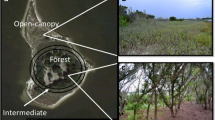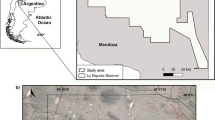Abstract
Two spatial tactics are usually distinguished in males of Calopteryx damselflies: territorial and nonterritorial. These tactics are believed to underlie two alternative condition-dependent reproductive tactics in these insects, and territorial males are believed to copulate more often. With age, males become weaker, turn nonterritorial, and only occasionally manage to copulate. However, the details of space use by damselflies are poorly known, which hinders the interpretation of the existing empirical data. We describe the space use by individually marked males of the banded demoiselle C. splendens studied during three field seasons in Vladimir Province, Russia. Each male on each day of observations was characterized as either territorial or non-territorial, and the sites of encounter were mapped. The probability of being territorial declined with the male’s age. The spatial tactics (territorial vs. non-territorial) on a given day strongly influenced the tactics used on the following day. We identified the territorial and non-territorial phases in the life of a male damselfly, which occurred consecutively and had a roughly similar duration. During the territorial phase, the male occupied a certain territory and tried to hold it as long as possible. The male abandoned its territory in two cases: (1) when it was driven onto a different territory as the result of competition with other males, or (2) when it was exhausted and became non-territorial. Thus, the space use by the male changed predictably during its life. Therefore, direct comparison of morphological or other characteristics in territorial vs. non-territorial males, frequently made in the literature, makes little sense. Further progress in studying the so-called “alternative reproductive tactics” in damselflies may be more successfully achieved by comparing individual life trajectories of different males (e.g. duration of territorial and non-territorial periods, the number of consecutively occupied territories, etc.). We performed correlation analysis and found that the above parameters did not depend on the wing and abdomen length of the males.
Similar content being viewed by others
References
Banks, M.J. and Thompson, D.J., “Lifetime Mating Success in the Damselfly Coenagrion puella,” Animal Behaviour 33, 1175–1183 (1985).
Beck, M.L. and Pruett-Jones, S., “Fluctuating Asymmetry, Sexual Selection, and Survivorship in Male Dark-Winged Damselfly,” Ethology 108, 779–791 (2002).
Chaput-Bardy, A., Gregoire, A., Baguette, M., Pagano, A., and Secondi, J., “Condition and Phenotype-Dependent Dispersal in a Damselfly, Calopteryx splendens,” PLoS ONE 5 (5), 1–7 (2010).
Contreras-Garduno, J., Canales-Lazcano, J., and Cordoba-Aguilar, A., “Wing Pigmentation, Immune Ability, Fat Reserves and Territorial Status in Males of the Rubyspot Damselfly, Hetaerina americana,” Journal of Ethology 24, 165–173 (2006).
Convey, P., “Influences on the Choice between Territorial and Satellite Behaviour in Male Libellula quadrimaculata Linn. (Odonata: Libellulidae),” Behaviour 109 (1–2), 125–141 (1988).
Corbet, P.S., Dragonflies: Behavior and Ecology of Odonata (Cornell University Press, New York, 1999).
Cordero, A., “Forced Copulations and Female Contact Guarding at a High Male Density in a Calopterygid Damselfly,” Journal of Insect Behaviour 12, 27–37 (1999).
Cordoba-Aguilar, A., “Male Territorial Tactics in the Damselfly Hetaerina cruentata (Rambur) (Zygoptera: Calopterygidae),” Odonatologica 24, 441–449 (1995).
Cordoba-Aguilar, A., “Reproductive Behavior of the Territorial Damselfly Calopteryx haemorrhoidalis asturica Ocharan (Zygoptera: Calopterygidae),” Odonatologica 29, 295–305 (2000).
Cordoba-Aguilar, A. and Cordero-Rivera, A., “Evolution and Ecology of Calopterygidae (Zygoptera: Odonata): Status of Knowledge and Research Perspective,” Neotropical Entomology 34, 861–879 (2005).
Fincke, O.M., “Alternative Copulate-Finding Tactics in a Non-Territorial Damselfly (Odonata: Coenagrionidae),” Animal Behaviour 33, 1124–1137 (1985).
Forsyth, A. and Montgomerie, R.D., “Alternative Reproductive Tactics in the Territorial Damselfly Calopteryx maculata: Sneaking by Older Males,” Behavioural Ecology and Sociobiology 21, 73–81 (1987).
Kirkton, S.D. and Schultz, T.D., “Age-Specific Behavior and Habitat Selection of Adult Male Damselflies, Calopteryx maculata (Odonata: Calopterygidae),” Journal of Insect Behaviour 14, 545–556 (2001).
Koskimäki, J., Rantala, M.J., and Suhonen, J., “Wandering Males are Smaller than Territorial Males in the Damselfly Calopteryx virgo (L.) (Zygoptera: Calopterygidae),” Odonatologica 38, 159–165 (2009).
Misof, B., Anderson, C.L., and Hadrys, H., “A Phylogeny of the Damselfly Genus Calopteryx (Odonata) Using Mitochondrial 16S rDNA Markers,” Molecular Phylogenetics and Evolution 15, 5–14 (2000).
Pajunen, V.I., “Aggressive Behavior and Territoriality in a Population of Calopteryx virgo L. (Odonata: Calopterygidae),” Annales Zoologici Fennici 3, 201–214 (1966).
Panov, E.N. and Opaev, A.S., “Behavior of Males in a Reproductive Aggregation of the Banded Demoiselle Calopteryx splendens (Insecta, Odonata),” Zoologicheskii Zhurnal 92 (1), 24–33 (2013) [Entomological Review 93 (7), 805–816 (2013)].
Panov, E.N., Opaev, A.S., and Pavlova, E.Yu., “The Social Organization of Reproductive Aggregations and Mating Behavior in Demoiselles (Insecta: Odonata: Calopterygidae),” Etologiya i Zoopsikhologiya, No. 2, 1–31 (2010).
Plaistow, S. and Siva-Jothy, M.T., “Energetic Constraints and Male Copulate-Securing Tactics in the Damselfly Calopteryx splendens xanthostoma (Charpentier),” Proceedings of the Royal Society of London B 263, 1233–1238 (1996).
Poethke, H.-J., “Density-Dependent Behavior in Aeshna cyanea (Muller) Males at the Mating Place (Anisoptera: Aeshnidae),” Odonatologica 17, 205–212 (1988).
Rehfeldt, G.E., “Site-Specific Copulate-Finding Strategies and Oviposition Behavior in Crocothemis erythraea (Brulle) (Odonata: Libellulidae),” Journal of Insect Behaviour 4, 293–303 (1991).
Siva-Jothy, M.T., “Male Wing Pigmentation May Affect Reproductive Success via Female Choice in a Calopterygid Damselfly (Zygoptera),” Behaviour 136 (10), 1365–1377 (1999).
Skvortsov, V.E., Dragonflies of East Siberia and the Caucasus: A Pictorial Key (KMK Scientific Press, Moscow, 2010) [in Russian].
Stettmer, C., “Colonization and Dispersal Patterns of Banded (Calopteryx splendens) and Beautiful Demoiselles (C. virgo) (Odonata: Calopterygidae) in South- East German Streams,” European Journal of Entomology 93, 579–593 (1996).
Tsubaki, Y. and Ono, T., “Competition for Territorial Site and Alternative Mating Tactics in the Dragonfly, Nannophya pygmaea Rambur (Odonata: Libellulidae),” Behaviour 97, 234–251 (1986).
Waage, J.K., “Evidence for Widespread Sperm Displacement Ability among Zygoptera (Odonata) and the Means for Predicting Its Presents,” Biological Journal of the Linnaean Society 28, 285–300 (1986).
Ward, L. and Mill, P.J., “Long Range Movements by Individuals as a Vehicle for Range Expansion in Calopteryx splendens (Odonata: Zygoptera),” European Journal of Entomology 104, 195–198 (2007).
White, G.C. and Burnham, K.P., “Program MARK: Survival Estimation from Populations of Marked Animals,” Bird Study 46 (Suppl. 1), 120–139 (1999).
Author information
Authors and Affiliations
Corresponding author
Additional information
Original Russian Text © A.S. Opaev and E.N. Panov, 2016, published in Zoologicheskii Zhurnal, 2016, Vol. 95, No. 4, pp. 417–428.
Rights and permissions
About this article
Cite this article
Opaev, A.S., Panov, E.N. Variations of space use in males of the banded demoiselle (Calopteryx splendens, Zygoptera, Odonata): Alternative tactics or an age-dependent trend?. Entmol. Rev. 96, 525–536 (2016). https://doi.org/10.1134/S001387381605002X
Received:
Published:
Issue Date:
DOI: https://doi.org/10.1134/S001387381605002X




